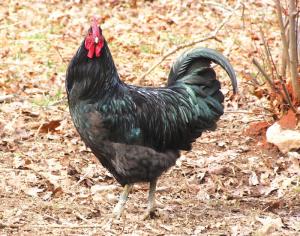America’s Second-Oldest Chicken Breed
 ✖  |
As the second-oldest chicken breed in America, the Java chicken is a long-time favorite of those lucky enough to raise them (for the record, Dominque is the oldest breed). Not only are the birds above-average egg layers, but they’re excellent for meat production, do well in cold weather, and are capable of foraging for much of their food.
Java chickens originated from various Asian breeds brought to the United States in the 1830’s and were officially recognized by the American Poultry Association’s Standard of Perfection in 1883. They were a popular dual-purpose breed on the East Coast for generations and became the ancestors of today’s meat breeds like the Jersey Giant, Rhode Island Red, and Plymouth Rock, each of which soon surpassed the Java in popularity. In fact, the breed nearly went extinct by the end of the 20th century until breeders brought it back from the brink. But even so, their populations are dwindling fast.
“Murray McMurray Hatchery sponsored The Livestock Conservancy’s 2021 Census, a comprehensive look at 7,500 flocks submitted by nearly 2,000 breeders and hatcheries,” says Dr. Judy Brummer, Interim Executive Director of The Livestock Conservancy. “Within it, just 327 breeding Java chickens were counted from private flocks and 200 in mail-order hatchery flocks. This is a significant decline since 2015 and has moved Java to a critical endangerment level on the Conservation Priority List.”
Today, two types of Java chickens are recognized: regular and bantam. These are found in black, mottled, and white color variations, although auburn coloring has also been reported. Overall, javas are a large breed with broad backs and a single small comb located farther back on the head than usual.
Javas are ideal homestead companions and thrive when given space to free range. Javas have a pleasant temperament and are known for being docile and calm, especially around kids and other chicken varieties. The birds lay large brown eggs and have good mothering instincts. Expect about three to four eggs per week once the birds start laying at 6 mos. old. While an excellent-tasting meat bird, Javas grow slowly and may take 6 mos. to reach their mature weight. That’s one of the reasons why they have been surpassed in popularity by the breeds they were used to create.
Connect with the Livestock Conservancy to find breeders near you to help keep this American heritage poultry breed alive.
Contact: FARM SHOW Followup, The Livestock Conservancy, PO Box 477, Pittsboro, N.C. 27312 (ph 919-542-5704; www.livestockconservancy.org).

Click here to download page story appeared in.
Click here to read entire issue
America’s Second-Oldest Chicken Breed LIVESTOCK Exotic Animals As the second-oldest chicken breed in America the Java chicken is a long-time favorite of those lucky enough to raise them for the record Dominque is the oldest breed Not only are the birds above-average egg layers but they’re excellent for meat production do well in cold weather and are capable of foraging for much of their food Java chickens originated from various Asian breeds brought to the United States in the 1830’s and were officially recognized by the American Poultry Association’s Standard of Perfection in 1883 They were a popular dual-purpose breed on the East Coast for generations and became the ancestors of today’s meat breeds like the Jersey Giant Rhode Island Red and Plymouth Rock each of which soon surpassed the Java in popularity In fact the breed nearly went extinct by the end of the 20th century until breeders brought it back from the brink But even so their populations are dwindling fast “Murray McMurray Hatchery sponsored The Livestock Conservancy’s 2021 Census a comprehensive look at 7 500 flocks submitted by nearly 2 000 breeders and hatcheries ” says Dr Judy Brummer Interim Executive Director of The Livestock Conservancy “Within it just 327 breeding Java chickens were counted from private flocks and 200 in mail-order hatchery flocks This is a significant decline since 2015 and has moved Java to a critical endangerment level on the Conservation Priority List ” Today two types of Java chickens are recognized: regular and bantam These are found in black mottled and white color variations although auburn coloring has also been reported Overall javas are a large breed with broad backs and a single small comb located farther back on the head than usual Javas are ideal homestead companions and thrive when given space to free range Javas have a pleasant temperament and are known for being docile and calm especially around kids and other chicken varieties The birds lay large brown eggs and have good mothering instincts Expect about three to four eggs per week once the birds start laying at 6 mos old While an excellent-tasting meat bird Javas grow slowly and may take 6 mos to reach their mature weight That’s one of the reasons why they have been surpassed in popularity by the breeds they were used to create Connect with the Livestock Conservancy to find breeders near you to help keep this American heritage poultry breed alive Contact: FARM SHOW Followup The Livestock Conservancy PO Box 477 Pittsboro N C 27312 ph 919-542-5704; www livestockconservancy org
To read the rest of this story, download this issue below or click
here to register with your account number.







